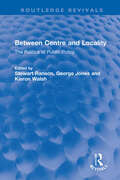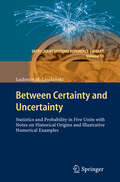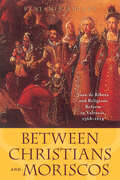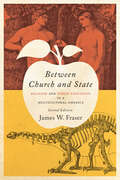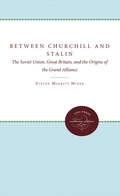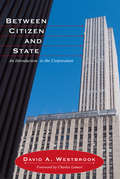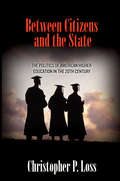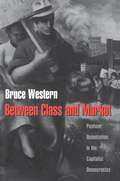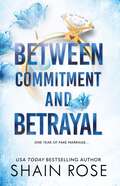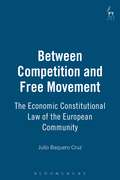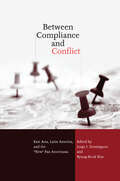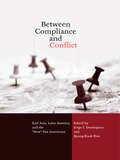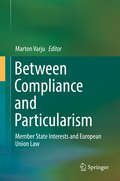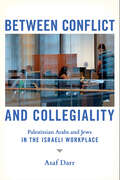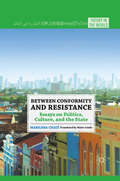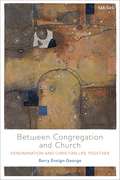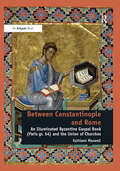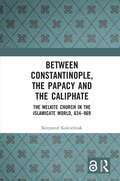- Table View
- List View
Between Centre and Locality: The Politics of Public Policy (Routledge Revivals)
by Stewart Ranson George Jones Kieron WalshFirst published in 1985, Between Centre and Locality provides the detailed accounts of the relations between central and local government in Britain since 1970s. The confrontation of centre and locality has been a constant theme of political debate and legislative action since Mrs Thatcher came to power. It discusses range of policy issues including education, the police, housing, race relations and finance. In addition, theoretical chapters are included which set the empirical studies in the broader context of theories of the State and of policy making. The chapters have each been written by an acknowledged authority on the particular subject and are based upon extensive research. The book will be of interest not only to academics in a number of fields but also to politicians, officers, and civil servants in central and local government.
Between Centre and Locality: The Politics of Public Policy (Routledge Revivals)
by Stewart Ranson George Jones Kieron WalshFirst published in 1985, Between Centre and Locality provides the detailed accounts of the relations between central and local government in Britain since 1970s. The confrontation of centre and locality has been a constant theme of political debate and legislative action since Mrs Thatcher came to power. It discusses range of policy issues including education, the police, housing, race relations and finance. In addition, theoretical chapters are included which set the empirical studies in the broader context of theories of the State and of policy making. The chapters have each been written by an acknowledged authority on the particular subject and are based upon extensive research. The book will be of interest not only to academics in a number of fields but also to politicians, officers, and civil servants in central and local government.
Between Certainty and Uncertainty: Statistics and Probability in Five Units with Notes on Historical Origins and Illustrative Numerical Examples (Intelligent Systems Reference Library #31)
by Ludomir M. Laudański„Between Certainty & Uncertainty” is a one-of–a-kind short course on statistics for students, engineers and researchers. It is a fascinating introduction to statistics and probability with notes on historical origins and 80 illustrative numerical examples organized in the five units: · Chapter 1 Descriptive Statistics: Compressing small samples, basic averages - mean and variance, their main properties including God’s proof; linear transformations and z-scored statistics . · Chapter 2 Grouped data: Udny Yule’s concept of qualitative and quantitative variables. Grouping these two kinds of data. Graphical tools. Combinatorial rules and qualitative variables. Designing frequency histogram. Direct and coded evaluation of quantitative data. Significance of percentiles. · Chapter 3 Regression and correlation: Geometrical distance and equivalent distances in two orthogonal directions as a prerequisite to the concept of two regression lines. Misleading in interpreting two regression lines. Derivation of the two regression lines. Was Hubble right? Houbolt’s cloud. What in fact measures the correlation coefficient? · Chapter 4 Binomial distribution: Middle ages origins of the binomials; figurate numbers and combinatorial rules. Pascal’s Arithmetical Triangle. Bernoulli’s or Poisson Trials? John Arbuthnot curing binomials. How Newton taught S. Pepys probability. Jacob Bernoulli’s Weak Law of Large Numbers and others. · Chapter 5 Normal distribution and binomial heritage – Tables of the normal distribution. Abraham de Moivre and the second theorem of de Moivre-Laplace. · Chapter 1 Descriptive Statistics: Compressing small samples, basic averages - mean and variance, their main properties including God’s proof; linear transformations and z-scored statistics . · Chapter 2 Grouped data: Udny Yule’s concept of qualitative and quantitative variables. Grouping these two kinds of data. Graphical tools. Combinatorial rules and qualitative variables. Designing frequency histogram. Direct and coded evaluation of quantitative data. Significance of percentiles. · Chapter 3 Regression and correlation: Geometrical distance and equivalent distances in two orthogonal directions as a prerequisite to the concept of two regression lines. Misleading in interpreting two regression lines. Derivation of the two regression lines. Was Hubble right? Houbolt’s cloud. What in fact measures the correlation coefficient? · Chapter 4 Binomial distribution: Middle ages origins of the binomials; figurate numbers and combinatorial rules. Pascal’s Arithmetical Triangle. Bernoulli’s or Poisson Trials? John Arbuthnot curing binomials. How Newton taught S. Pepys probability. Jacob Bernoulli’s Weak Law of Large Numbers and others. · Chapter 5 Normal distribution and binomial heritage – Tables of the normal distribution. Abraham de Moivre and the second theorem of de Moivre-Laplace. · Chapter 5 Normal distribution and binomial heritage – Tables of the normal distribution. Abraham de Moivre and the second theorem of de Moivre-Laplace.
Between Christians and Moriscos: Juan de Ribera and Religious Reform in Valencia, 1568–1614 (The Johns Hopkins University Studies in Historical and Political Science #124)
by Benjamin EhlersIn early modern Spain the monarchy's universal policy to convert all of its subjects to Christianity did not end distinctions among ethnic religious groups, but rather made relations between them more contentious. Old Christians, those whose families had always been Christian, defined themselves in opposition to forcibly baptized Muslims (moriscos) and Jews (conversos). Here historian Benjamin Ehlers studies the relations between Christians and moriscos in Valencia by analyzing the ideas and policies of archbishop Juan de Ribera. Juan de Ribera, a young reformer appointed to the diocese of Valencia in 1568, arrived at his new post to find a congregation deeply divided between Christians and moriscos. He gradually overcame the distrust of his Christian parishioners by intertwining Tridentine themes such as the Eucharist with local devotions and holy figures. Over time Ribera came to identify closely with the interests of his Christian flock, and his hagiographers subsequently celebrated him as a Valencian saint. Ribera did not engage in a similarly reciprocal exchange with the moriscos; after failing to effect their true conversion through preaching and parish reform, he devised a covert campaign to persuade the king to banish them. His portrayal of the moriscos as traitors and heretics ultimately justified the Expulsion of 1609–1614, which Ribera considered the triumphant culmination of the Reconquest. Ehler's sophisticated yet accessible study of the pluralist diocese of Valencia is a valuable contribution to the study of Catholic reform, moriscos, Christian-Muslim relations in early modern Spain, and early modern Europe.
Between Church and State: Religion and Public Education in a Multicultural America
by James W. FraserToday, the ongoing controversy about the place;¢;‚¬;€?or lack of place;¢;‚¬;€?of religion in public schools is a burning issue in the United States. Prayer at football games, creationism in the classroom, the teaching of religion and morals, and public funding for private religious schools are just a few of the subjects over which people are skirmishing. In Between Church and State, historian and pastor James W. Fraser shows that these battles have been going on for as long as there have been public schools and argues there has never been any consensus about what the "separation of church and state" means for American society or about the proper relationship between religion and public education.Looking at the difficult question of how private issues of faith can be reconciled with the very public nature of schooling, Fraser;€™s classic book paints a complex picture of how a multicultural society struggles to take the deep commitments of people of faith into account;¢;‚¬;€?including people of many different faiths and no faith. In this fully updated second edition, Fraser tackles the culture wars, adding fresh material on current battles over public funding for private religious schools. He also addresses the development of the long-simmering evolution-creationism debate and explores the tensions surrounding a discussion of religion and the accommodation of an increasingly religiously diverse American student body.Between Church and State includes new scholarship on the role of Roger Williams and William Penn in developing early American conceptions of religious liberty. It traces the modern expansion of Catholic parochial schools and closely examines the passage of the First Amendment, changes in American Indian tribal education, the place of religion in Booker T. Washington and W. E. B. Du Bois;€™s debates about African American schooling, and the rapid growth of Jewish day schools among a community previously known for its deep commitment to secular public education.
Between Church and State: Religion and Public Education in a Multicultural America
by James W. FraserToday, the ongoing controversy about the place;¢;‚¬;€?or lack of place;¢;‚¬;€?of religion in public schools is a burning issue in the United States. Prayer at football games, creationism in the classroom, the teaching of religion and morals, and public funding for private religious schools are just a few of the subjects over which people are skirmishing. In Between Church and State, historian and pastor James W. Fraser shows that these battles have been going on for as long as there have been public schools and argues there has never been any consensus about what the "separation of church and state" means for American society or about the proper relationship between religion and public education.Looking at the difficult question of how private issues of faith can be reconciled with the very public nature of schooling, Fraser;€™s classic book paints a complex picture of how a multicultural society struggles to take the deep commitments of people of faith into account;¢;‚¬;€?including people of many different faiths and no faith. In this fully updated second edition, Fraser tackles the culture wars, adding fresh material on current battles over public funding for private religious schools. He also addresses the development of the long-simmering evolution-creationism debate and explores the tensions surrounding a discussion of religion and the accommodation of an increasingly religiously diverse American student body.Between Church and State includes new scholarship on the role of Roger Williams and William Penn in developing early American conceptions of religious liberty. It traces the modern expansion of Catholic parochial schools and closely examines the passage of the First Amendment, changes in American Indian tribal education, the place of religion in Booker T. Washington and W. E. B. Du Bois;€™s debates about African American schooling, and the rapid growth of Jewish day schools among a community previously known for its deep commitment to secular public education.
Between Churchill and Stalin: The Soviet Union, Great Britain, and the Origins of the Grand Alliance
by Steven Merritt MinerIt is well documented that relations between the Allies and the Soviet Union were deteriorating from 1943. This volume examines the causes of this conflict that may, in fact, have started in 1940 with the problems of the Baltic states.Originally published 1988.A UNC Press Enduring Edition -- UNC Press Enduring Editions use the latest in digital technology to make available again books from our distinguished backlist that were previously out of print. These editions are published unaltered from the original, and are presented in affordable paperback formats, bringing readers both historical and cultural value.
Between Citizen and State: An Introduction to the Corporation
by David A. WestbrookBetween Citizen and State is an intrepid and readable introduction to, and insightful commentary on, the role of the corporation in the modern world. Corporate actors have typical motivations, opportunities, temptations - they are characters, and their interactions follow familiar plotlines. Part I, Background, introduces the characters and their context. Part II, Internal Struggles, explains common conflicts in terms of well-known court cases. Part III, External Relations, examines relationships between the corporation, individuals, and the state.
Between Citizen and State: An Introduction to the Corporation
by David A. WestbrookBetween Citizen and State is an intrepid and readable introduction to, and insightful commentary on, the role of the corporation in the modern world. Corporate actors have typical motivations, opportunities, temptations - they are characters, and their interactions follow familiar plotlines. Part I, Background, introduces the characters and their context. Part II, Internal Struggles, explains common conflicts in terms of well-known court cases. Part III, External Relations, examines relationships between the corporation, individuals, and the state.
Between Citizens and the State: The Politics of American Higher Education in the 20th Century
by Christopher P. LossThis book tracks the dramatic outcomes of the federal government's growing involvement in higher education between World War I and the 1970s, and the conservative backlash against that involvement from the 1980s onward. Using cutting-edge analysis, Christopher Loss recovers higher education's central importance to the larger social and political history of the United States in the twentieth century, and chronicles its transformation into a key mediating institution between citizens and the state. Framed around the three major federal higher education policies of the twentieth century--the 1944 GI Bill, the 1958 National Defense Education Act, and the 1965 Higher Education Act--the book charts the federal government's various efforts to deploy education to ready citizens for the national, bureaucratized, and increasingly global world in which they lived. Loss details the myriad ways in which academic leaders and students shaped, and were shaped by, the state's shifting political agenda as it moved from a preoccupation with economic security during the Great Depression, to national security during World War II and the Cold War, to securing the rights of African Americans, women, and other previously marginalized groups during the 1960s and '70s. Along the way, Loss reappraises the origins of higher education's current-day diversity regime, the growth of identity group politics, and the privatization of citizenship at the close of the twentieth century. At a time when people's faith in government and higher education is being sorely tested, this book sheds new light on the close relations between American higher education and politics.
Between Citizens and the State: The Politics of American Higher Education in the 20th Century (PDF)
by Christopher P. LossThis book tracks the dramatic outcomes of the federal government's growing involvement in higher education between World War I and the 1970s, and the conservative backlash against that involvement from the 1980s onward. Using cutting-edge analysis, Christopher Loss recovers higher education's central importance to the larger social and political history of the United States in the twentieth century, and chronicles its transformation into a key mediating institution between citizens and the state. Framed around the three major federal higher education policies of the twentieth century--the 1944 GI Bill, the 1958 National Defense Education Act, and the 1965 Higher Education Act--the book charts the federal government's various efforts to deploy education to ready citizens for the national, bureaucratized, and increasingly global world in which they lived. Loss details the myriad ways in which academic leaders and students shaped, and were shaped by, the state's shifting political agenda as it moved from a preoccupation with economic security during the Great Depression, to national security during World War II and the Cold War, to securing the rights of African Americans, women, and other previously marginalized groups during the 1960s and '70s. Along the way, Loss reappraises the origins of higher education's current-day diversity regime, the growth of identity group politics, and the privatization of citizenship at the close of the twentieth century. At a time when people's faith in government and higher education is being sorely tested, this book sheds new light on the close relations between American higher education and politics.
Between Class and Market: Postwar Unionization in the Capitalist Democracies
by Bruce WesternIn the United States, less than one worker in five is currently in a labor union, while in Sweden, virtually the entire workforce is unionized. Despite compelling evidence for their positive effects, even the strongest European unions are now in retreat as some policymakers herald the U.S. model of market deregulation. These differences in union power significantly affect workers' living standards and the fortunes of national economies. What explains the enormous variation in unionization and why has the last decade been so hostile to organized labor? Bruce Western tackles these questions in an analysis of labor union organization in eighteen capitalist democracies from 1950 to 1990. Combining insights from sociology and economics in a novel way, Western views unions as the joint product of market forces and political and economic institutions. The author argues that three institutional conditions are essential for union growth: strong working-class political parties, centralized collective bargaining, and union-run unemployment insurance. These conditions shaped the impact of market currents and explain variations across industries, across countries, and over time for the four decades since 1950. Between Class and Market traces the story of the postwar labor movements supported by a blend of historical investigation and sophisticated statistical analysis in an innovative framework for comparative research. Western tightly integrates institutional explanation and comparative method in a way that balances comparative generality with the unique historical experiences of specific cases.
BETWEEN COMMITMENT AND BETRAYAL: a dark, fake-dating romance from the Tiktok sensation and USA Today bestselling author (The Hardy Billionaires Series)
by Shain RoseOUR MARRIAGE ISN'T REAL. SO WHY DO OUR KISSES FEEL SO GOOD?Declan Hardy, heartthrob and retired billionaire, is my complete opposite.He's commanding: I'm cooperative.He's loud when I stay quiet.All we have in common is that both our names are on my father's will.He'll inherit an empire - and I'll keep the one thing I hold dear.But there's a catch: I have to marry him - or at least, pretend to.One year of fake marriage.One year of living together.But it's not that simple.Especially when I can't tell if his kisses are fake - and if I'm really still pretending when I kiss him back...There's a fine line between commitment and betrayal... and neither of us knows where it falls. Declan and I would never work for real - or would we?A HOT, DARK ROMANCE FROM THE TIKTOK SENSATION - SHAIN ROSE IS YOUR NEW OBSESSION.
Between Competition and Free Movement: The Economic Constitutional Law of the European Community
by Julio Baquero CruzThis book takes as its starting point the interaction and gaps between the free movement and competition rules of the EC Treaty,and is the first book-length treatment of the topic. Competition and free movement are well known as fundamental elements of the Community legal order and are normally treated separately by different specialists. Hence their interaction has tended to receive less doctrinal analysis. This work bridges the gap and examines the interaction of these disparate rules using a framework which is defined by the author as the economic constitutional law of the European Community. The book then examines in depth specific issues such as, for example, the economic orientation of the constitution of the Community, the structure and principles of interpretation relating to it, or the gaps presented by this structure and the ways in which they have been filled by the European Court of Justice. Particular attention is given, in separate chapters, to two important topics: the possible extension of the application of the free movement rules to protectionist private conduct and that of the competition rules or principles extracted from them to State action. The problem of the public/private divide, a pressing one for contemporary constitutionalism and societies, is a major concern for the chapters devoted to these topics, and it is seen by the author as the central question of the economic constitutional law of the Community. The book is equally concerned with theoretical and practical issues, and will be of use and interest to academics and practitioners interested in the European Community legal order. In addition to the wealth of information it contains and its challenging analysis of the law, the book also provides a way of thinking afresh about the problems presented by these established branches of Community law.
Between Compliance and Conflict: East Asia, Latin America and the "New" Pax Americana
by Jorge I. Domínguez Byung-Kook KimThis book examines the responses to U.S. power in the two areas of the world where U.S. primacy was first successfully consolidated: East Asia and Latin America. The U.S. has faced no comparably powerful challengers to the exercise of its power in Latin America for much of the past century. It established its primacy over much of East Asia in the aftermath of WW II and extended its influence in the late 1970's and after the end of the Vietnam War through its entente with China to balance the Soviet Union. By contrast, the U.S. has always encountered rivals and challengers in Europe, has attempted unsuccessfully thus far to impose its primacy in the Middle East, and has paid only intermittent attention to South Asia and Africa. The essays in this volume will explore three important themes 1.) How do region-wide economic trends and arrangements sustain or modify U.S. influence in the region? 2.) How do rising powers in these regions (Japan, China, Brazil) reshape their policies to cope with the U.S. and 3.) How do new (South Korea) and old (Cuba) challengers to U.S. power shape their policies to account for the unrivaled exercise of U.S. power. This collection will place the United States at the hub of relations with countries in East Asia and Latin America and examine the new policies and new styles of engagement that are employed to address the prolonged U.S. interest in these areas-approaches from which the rest of the world might learn.
Between Compliance and Conflict: East Asia, Latin America and the "New" Pax Americana
by Jorge Dominguez Byung-Kook KimThis book examines the responses to U.S. power in the two areas of the world where U.S. primacy was first successfully consolidated: East Asia and Latin America. The U.S. has faced no comparably powerful challengers to the exercise of its power in Latin America for much of the past century. It established its primacy over much of East Asia in the aftermath of WW II and extended its influence in the late 1970's and after the end of the Vietnam War through its entente with China to balance the Soviet Union. By contrast, the U.S. has always encountered rivals and challengers in Europe, has attempted unsuccessfully thus far to impose its primacy in the Middle East, and has paid only intermittent attention to South Asia and Africa. The essays in this volume will explore three important themes 1.) How do region-wide economic trends and arrangements sustain or modify U.S. influence in the region? 2.) How do rising powers in these regions (Japan, China, Brazil) reshape their policies to cope with the U.S. and 3.) How do new (South Korea) and old (Cuba) challengers to U.S. power shape their policies to account for the unrivaled exercise of U.S. power. This collection will place the United States at the hub of relations with countries in East Asia and Latin America and examine the new policies and new styles of engagement that are employed to address the prolonged U.S. interest in these areas-approaches from which the rest of the world might learn.
Between Compliance and Particularism: Member State Interests and European Union Law
by Marton VarjuThe book examines how the interests of the member states, which provide the primary driving force for developments in European integration, are internalised and addressed by the law of the European Union. In this context, member state interests are taken to mean the policy considerations, economic calculations, local socio-cultural factors, and the raw expressions of political will which shape EU policies and determine member state responses to the obligations arising from those policies. The book primarily explores the junctions and disjunctions between member state interests defined in such a manner and EU law, where the latter expresses either an obligation for the member states to comply with common policies or an acceptance of member state particularism under the common EU framework.
Between Conflict and Collegiality: Palestinian Arabs and Jews in the Israeli Workplace
by Asaf DarrBetween Conflict and Collegiality explores how ethnonational-religious struggle between Jews and Palestinians affects relations in ethnically mixed work teams in Israel. Asaf Darr documents the tensions that permeate the workplace and reveals when such tensions threaten the cohesion of the work environment. Darr chronicles the grassroots coping strategies employed by both Jewish and Palestinian through field studies conducted with workers in various sectors in Israel, adopting a comparative method that identifies the differences in how ethnonational-religious tensions play out. Between Conflict and Collegiality asks how workers deal with external ethnonational and religious pressures and whether the broader ethnonational conflict is reflected in the career expectations and trajectories of minority group members. Darr examines whether minority group members' use of their own language at work become a point of contestation; how religion is manifested in the workplace; whether co-workers from different ethnonational groups form amicable relations that extend beyond the workplace; and whether positive experiences working in ethnically mixed workplaces have the potential to mitigate conflict in the wider society.
Between Conformity and Resistance: Essays on Politics, Culture, and the State (Theory in the World)
by M. ChauíSince the 1980's, Marilena Chauí's writing has had a profound impact in Brazil, contributing to the academic conversation and resonating in popular culture. Here, in English for the first time, are ten of Chauí's most important essays, with an introduction by Maite Conde which situates the scholarship in the global context.
Between Congregation and Church: Denomination and Christian Life Together
by Barry A. Ensign-GeorgeDenominations are one of the primary ways in which Christians attempt to live in a community based around God. Yet there is very little careful theological analysis of denomination available today. Between Congregation and Church offers a constructive theological understanding of denomination, showing its role as an intermediary structure between congregation and church. It places denomination and other intermediary structures within the doctrine of the church. Barry Ensign-George reviews work by theologians and church historians that can contribute to a constructive theological understanding of denomination. The book highlights particular developments in the history of the church that established preconditions for the emergence of denomination. Exploration of unity and diversity is central to this analysis, and individual chapters offer theological analyses of the unity and the diversity to which the Christians are called. Finally, denomination has often been a vehicle for sin, and the relationship between denomination and sin is considered.Between Congregation and Church addresses a major gap in contemporary theology: the failure to offer substantive theological analysis of denomination, a major way Christians together live their faith today.
Between Congregation and Church: Denomination and Christian Life Together
by Rev Barry A. Ensign-GeorgeDenominations are one of the primary ways in which Christians attempt to live in a community based around God. Yet there is very little careful theological analysis of denomination available today. Between Congregation and Church offers a constructive theological understanding of denomination, showing its role as an intermediary structure between congregation and church. It places denomination and other intermediary structures within the doctrine of the church. Barry Ensign-George reviews work by theologians and church historians that can contribute to a constructive theological understanding of denomination. The book highlights particular developments in the history of the church that established preconditions for the emergence of denomination. Exploration of unity and diversity is central to this analysis, and individual chapters offer theological analyses of the unity and the diversity to which the Christians are called. Finally, denomination has often been a vehicle for sin, and the relationship between denomination and sin is considered.Between Congregation and Church addresses a major gap in contemporary theology: the failure to offer substantive theological analysis of denomination, a major way Christians together live their faith today.
Between Constantinople and Rome: An Illuminated Byzantine Gospel Book (Paris gr. 54) and the Union of Churches
by Kathleen MaxwellThis is a study of the artistic and political context that led to the production of a truly exceptional Byzantine illustrated manuscript. Paris, Bibliothèque Nationale de France, codex grec 54 is one of the most ambitious and complex manuscripts produced during the Byzantine era. This thirteenth-century Greek and Latin Gospel book features full-page evangelist portraits, an extensive narrative cycle, and unique polychromatic texts. However, it has never been the subject of a comprehensive study and the circumstances of its commission are unknown. In this book Kathleen Maxwell addresses the following questions: what circumstances led to the creation of Paris 54? Who commissioned it and for what purpose? How was a deluxe manuscript such as this produced? Why was it left unfinished? How does it relate to other Byzantine illustrated Gospel books? Paris 54's innovations are a testament to the extraordinary circumstances of its commission. Maxwell's multi-disciplinary approach includes codicological and paleographical evidence together with New Testament textual criticism, artistic and historical analysis. She concludes that Paris 54 was never intended to copy any other manuscript. Rather, it was designed to eclipse its contemporaries and to physically embody a new relationship between Constantinople and the Latin West, as envisioned by its patron. Analysis of Paris 54's texts and miniature cycle indicates that it was created at the behest of a Byzantine emperor as a gift to a pope, in conjunction with imperial efforts to unify the Latin and Orthodox churches. As such, Paris 54 is a unique witness to early Palaeologan attempts to achieve church union with Rome.
Between Constantinople and Rome: An Illuminated Byzantine Gospel Book (Paris gr. 54) and the Union of Churches
by Kathleen MaxwellThis is a study of the artistic and political context that led to the production of a truly exceptional Byzantine illustrated manuscript. Paris, Bibliothèque Nationale de France, codex grec 54 is one of the most ambitious and complex manuscripts produced during the Byzantine era. This thirteenth-century Greek and Latin Gospel book features full-page evangelist portraits, an extensive narrative cycle, and unique polychromatic texts. However, it has never been the subject of a comprehensive study and the circumstances of its commission are unknown. In this book Kathleen Maxwell addresses the following questions: what circumstances led to the creation of Paris 54? Who commissioned it and for what purpose? How was a deluxe manuscript such as this produced? Why was it left unfinished? How does it relate to other Byzantine illustrated Gospel books? Paris 54's innovations are a testament to the extraordinary circumstances of its commission. Maxwell's multi-disciplinary approach includes codicological and paleographical evidence together with New Testament textual criticism, artistic and historical analysis. She concludes that Paris 54 was never intended to copy any other manuscript. Rather, it was designed to eclipse its contemporaries and to physically embody a new relationship between Constantinople and the Latin West, as envisioned by its patron. Analysis of Paris 54's texts and miniature cycle indicates that it was created at the behest of a Byzantine emperor as a gift to a pope, in conjunction with imperial efforts to unify the Latin and Orthodox churches. As such, Paris 54 is a unique witness to early Palaeologan attempts to achieve church union with Rome.
Between Constantinople, the Papacy, and the Caliphate: The Melkite Church in the Islamicate World, 634-969
by Krzysztof KościelniakThis volume examines the Melkite church from the Arab invasion of Syria in 634 until 969. The Melkite Patriarchates were established in Antioch, Jerusalem and Alexandria and, following the Arab campaigns in Syria and Egypt, they all came under the new Muslim state. Over the next decades the Melkite church underwent a process of gradual marginalization, moving from the privileged position of the state confession to becoming one of the religious minorities of the Caliphate. This transition took place in the context of theological and political interactions with the Byzantine Empire, the Patriarchate of Constantinople, the Papacy and, over time, with the reborn Roman Empire in the West. Exploring the various processes within the Melkite church this volume also examines Caliphate–Byzantine interactions, the cultural and religious influences of Constantinople, the synthesis of Greek, Arab and Syriac elements, the process of Arabization of communities, and Melkite relations with distant Rome.
Between Constantinople, the Papacy, and the Caliphate: The Melkite Church in the Islamicate World, 634-969
by Krzysztof KościelniakThis volume examines the Melkite church from the Arab invasion of Syria in 634 until 969. The Melkite Patriarchates were established in Antioch, Jerusalem and Alexandria and, following the Arab campaigns in Syria and Egypt, they all came under the new Muslim state. Over the next decades the Melkite church underwent a process of gradual marginalization, moving from the privileged position of the state confession to becoming one of the religious minorities of the Caliphate. This transition took place in the context of theological and political interactions with the Byzantine Empire, the Patriarchate of Constantinople, the Papacy and, over time, with the reborn Roman Empire in the West. Exploring the various processes within the Melkite church this volume also examines Caliphate–Byzantine interactions, the cultural and religious influences of Constantinople, the synthesis of Greek, Arab and Syriac elements, the process of Arabization of communities, and Melkite relations with distant Rome.
